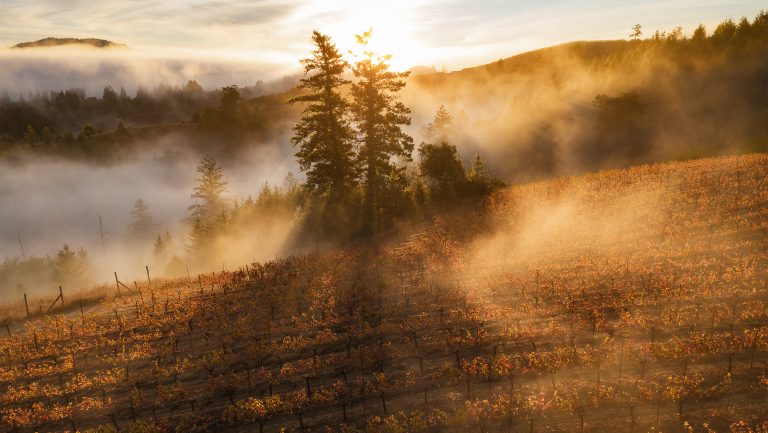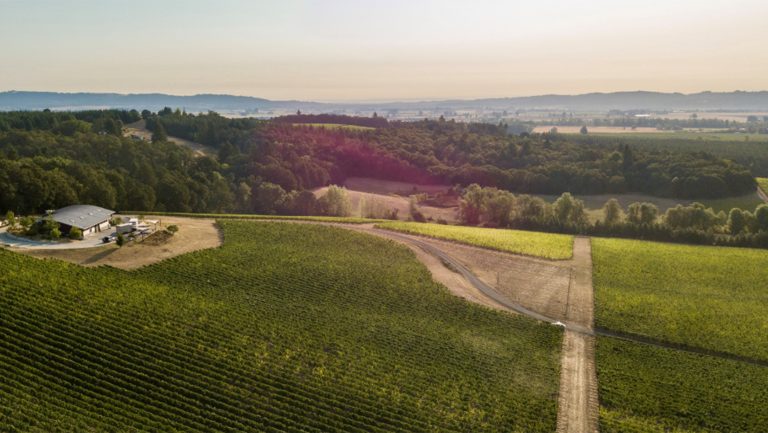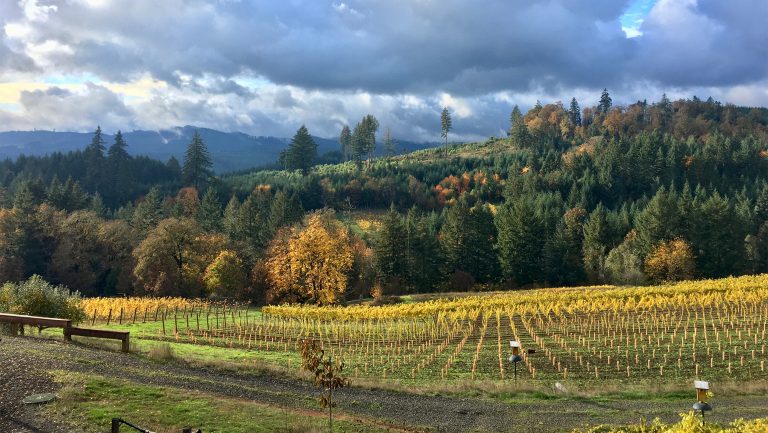The list of West Coast AVAs continues to expand and evolve as U.S. winegrowers increasingly become familiar with the varied terroir. In the past year, Washington established its 20th AVA, Oregon’s Willamette Valley gained its 10th and 11th, and a new addition in California became the state’s coolest growing region. On the horizon is a proposed addition to Sonoma County whose micro-terroir differentiates itself from the overall Alexander Valley.
SevenFifty Daily spoke with wine professionals affiliated with the new AVAs to better understand each region’s unique and noteworthy aspects, and which grape varieties show the most promise.
Rocky Reach AVA
Designated as Washington’s 20th AVA in June 2022, Rocky Reach AVA straddles the Columbia River and is located between Chelan and Wenatchee in the Columbia Valley. It covers 32,333 acres, with 117 acres under vine, and is named for the term that 18th-century steamboat captains used to describe the area’s rocky stretch of rapids. The underlying bedrock here is composed of metamorphosed sedimentary and igneous rocks rich in silica, mica, and quartz, rather than the basalt found elsewhere in the state. “A distinct minerality fused with ripe fruit expresses itself in the wines,” according to John Ware, the president of Rocky Pond Estate Winery.

Don’t miss the latest drinks industry news and insights. Sign up for our award-winning newsletters and get insider intel, resources, and trends delivered to your inbox every week.
Warmer than nearby Lake Chelan AVA with a higher percentage of heat-retaining granite cobblestones that promote faster, even ripening, Rocky Reach AVA also has stony soils that allow roots to dig deep; not surprisingly, Rhône varieties like Syrah and Grenache show promise, as well as Bordeaux grapes like Merlot and Malbec. “There is an undertone of gravel coupled with broad-shouldered structure and tension that’s an interplay of tannins,” says Rocky Pond winemaker Elizabeth Keyser. “The wines achieve concentration without presenting as monolithic or heavy.”

West Sonoma Coast AVA
Officially recognized in May 2022, the West Sonoma Coast AVA is located on the westernmost sliver of Sonoma County, around seven miles from the ocean. While the area encompasses 141,500 acres and three sub-regions (Annapolis, Fort Ross Seaview AVA, and Occidental-Freestone), the AVA’s steep and forested terrain translate to just 1,000 planted acres.
“The region is very different because it is a cold, mountainous, maritime region,” explains Carroll Kemp, the winemaker and cofounder of Alma Fria. “Most maritime regions are warmer, and most cool climates are not located on the oceans.” Yearly temperatures range from 50 to 53 degrees—10 or more degrees cooler than the rest of the Sonoma County AVA—and vineyards are planted at elevations of 400 to 1,800 feet on ridge tops formed from seismic activity along the San Andreas Fault on marine-based sedimentary rock.
Chardonnay thrives here, with a style leaning towards citrus rather than tropical fruits and a lively acidity, and the cool, maritime climate creates a profoundly distinct style of Pinot Noir, according to Erin Brooks, the founder and proprietor of Ernest Vineyards. “The wine becomes nuanced and more about the subtleties and specificities of the variety versus the common fruit-forward nature most people are used to.”

Lower Long Tom AVA
A major distinction about the Lower Long Tom AVA, which is located between Corvallis and Eugene, is that it’s the first AVA in Oregon’s southern Willamette Valley—the next closest is an hour’s drive to the north. “The relative seclusion of our AVA has inspired a kind of rugged individualism…where farmers and makers have struck out on their own paths,” says Andrew Smith, the winemaker and general manager at Antiquum Farm.
Another feature is the prominent ridgeline that lies to the west within the Coast Range. These high peaks that drop off to the south and north serve as a rain shadow protecting vineyards from storms (especially during the spring and fall), decreasing the chance of disease, ensuring even ripening and providing a longer picking window.
“Lower Long Tom AVA has the perfect mix of marine sedimentary and volcanic soils with clay that have the unique ability to be both well-draining yet retain moisture,” explains Gretchen Boock, the general manager at Benton-Lane Winery. Though the total area is 25,000 acres, only 575 are planted, mostly with Pinot Noir, and Pinot Gris is the most-planted white grape.
According to Matt Shown, the winemaker at Brigadoon Wine Co., the shallow Bellpine soils over sandstone that are ubiquitous here “create a smaller canopy with more exposed fruit and a more structured Pinot Noir, especially early in the wine’s life.”

SLO Coast AVA
This AVA approved in March 2022 is believed to be California’s coolest wine growing region and also has one of the world’s longest growing seasons. Encompassing 408,585 acres with 5,000 under vine, the SLO Coast AVA stretches from the northern border of San Luis Obispo County near Big Sur to the southern border with Santa Barbara County and includes land west of the ridgeline of the Santa Lucia Mountains.
Its 30 member wineries average just five miles from the coast, and evening winds and fog allow hang time into November. Soil types include fossilized shells, shale, and sand, and marine conditions make for complex and balanced wines with verve and vivacity. “These are wines of honesty and transparency that reflect the vineyards they’re grown in,” says Dan Fredman, the executive director of the SLO Coast AVA Collective.
“The SLO Coast AVA’s seafront soils, coastal fog, and generous diurnal range are what immediately captured my attention,” says Rachel Martin, the founder and CEO of Oceano Wines. “Wines display bright acidity, freshness, moderate alcohol, and pure flavors with loads of salinity.” SLO Coast AVA Pinot Noir tastes of juicy pomegranate and raspberry with nuances of rose and violet. Chardonnay shows citrus pith and high-toned tropical notes of passion fruit and guava, and the northern Spain-like climate has made Albariño a local surprise.

Mount Pisgah, Polk County, Oregon AVA
The namesake 835-foot mountain in the Mount Pisgah AVA formed 65 million years ago as a seafloor volcano. The base is Siletz rock, the oldest rock formation in the Willamette Valley, which is covered with marine sediment and unique, shallow soils including Willakenzie, Bellpine, Jory, and Nekia, which promote berry development and complexity. The cool Van Duzer winds coming from the Pacific bring with it a moderating effect, while Laurel Mountain to the west serves as a rain shadow.
Covering 5,530 acres of land in Polk County, six miles from the Willamette River, there are currently 584 acres under vine, making it the second-smallest AVA in the Willamette Valley with three wineries yet it’s also one of its most densely-planted. Pinot Noir, Pinot Gris, Chardonnay, Tempranillo, and Pinot Blanc are the prominent grapes. “The wines made from fruit from the Freedom Hill vineyard are what are most associated with this AVA,” says Andy Fortgang, the owner of Le Pigeon, Canard, and Flor Wines. “Curiously, I always find the whites quite bright and mineral driven, while Pinot Noir tends to be more stern and structured.”
Gabilan Mountains AVA
The newest AVA, approved in September 2022, is made up of 98,000 acres on California’s central coast. Located in the mountainous region between Monterey and San Benito counties, the Gabilan Mountains AVA stands out for its high elevation: no vineyard can be lower than 1,520 feet, and therefore, all vineyards lie above the fog line.
Bradley Brown, the founder of Big Basin Vineyards, originally had the idea for the AVA about eight years ago. “By creating this bigger AVA, we have this bigger geologic feature that really ties together the different vineyards throughout the area,” says Brown. “Before, the wines were labeled as Monterey Country, which is totally meaningless.” For Brown, wines from Gabilan Mountains, which are largely grown on decomposed granite soils, stand out for their dark color, richness of fruit, tannic backbone, naturally high acidity, and good structure that allows the wines to age exceptionally well.

Pocket Peak AVA
Earlier this year, a group of Sonoma County winegrowers filed a petition to establish the Pocket Peak AVA, which is located in the Alexander Valley at the foothills of Pocket Peak, Geyser Peak, and Black Mountain. Named for the nearby summit, the proposed AVA covers around 30,755 acres with 2,915 acres under vine. “Pocket Peak has an array of well-drained soils and topography to get early hydric stress on the vines, leading to smaller berries and more concentration,” according to Jesse Katz, the founder and winemaker of Aperture Cellars and Devil Proof Vineyards.
He goes on to add that the higher elevation lends structure, and lack of a mountain range on the western side allows for large diurnal temperature shifts because of the marine influence of the cold Pacific Ocean. Overall though, the area is generally warmer than the Alexander Valley, with more diverse soil types and rainfall. Late-ripening varieties like Cabernet Sauvignon and Petit Verdot thrive in the ample heat and elevation, while Chardonnay picks up intense fruit while retaining vibrant acidity.

Dispatch
Sign up for our award-winning newsletter
Don’t miss the latest drinks industry news and insights—delivered to your inbox every week.
Kelly Magyarics is a wine, spirits, travel, and lifestyle writer in the Washington, D.C. area who holds the WSET Diploma. You can reach her on her website, kellymagyarics.com and on Twitter and Instagram @kmagyarics.







